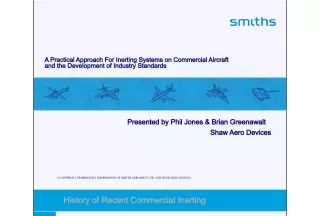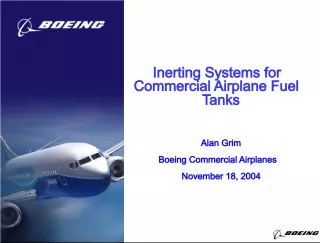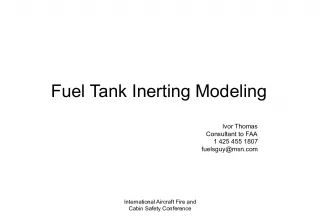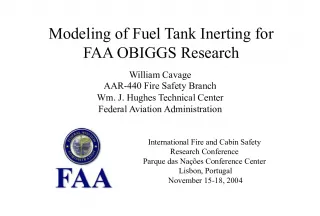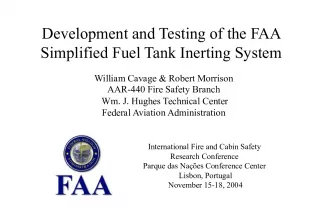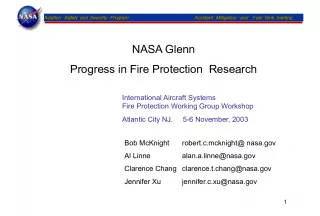A Different Look at Inerting InFlight
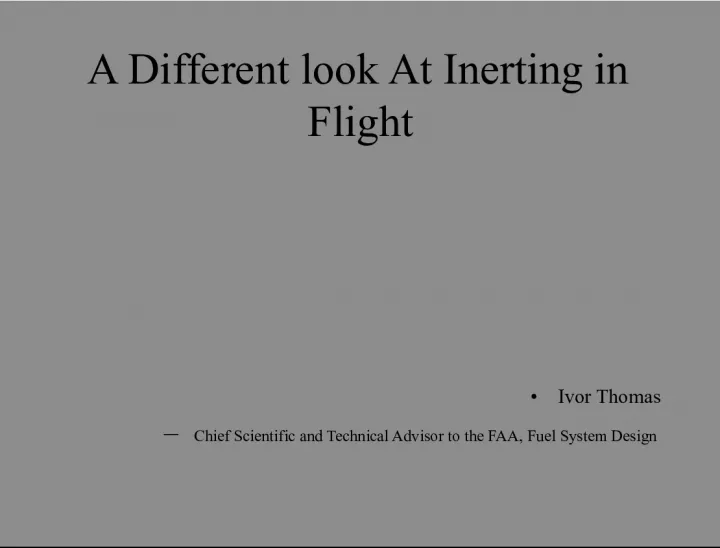

In this article, Ivor Thomas, the Chief Scientific and Technical Advisor to the FAA Fuel System Design, presents a new approach to inerting in-flight. The current approach has been
- Uploaded on | 0 Views
-
 selim
selim
About A Different Look at Inerting InFlight
PowerPoint presentation about 'A Different Look at Inerting InFlight'. This presentation describes the topic on In this article, Ivor Thomas, the Chief Scientific and Technical Advisor to the FAA Fuel System Design, presents a new approach to inerting in-flight. The current approach has been. The key topics included in this slideshow are . Download this presentation absolutely free.
Presentation Transcript
Slide1A Different look At Inerting inFlight • Ivor Thomas – Chief Scientific and Technical Advisor to the FAA, Fuel System Design
Slide2A Different look At Inerting inFlight • Current approach has been to look at how to get high quality NEA (>5% O 2 ). • This leads to needing high bleed pressures and also results in lower efficiency ASM performance (30% NEA recovery).
Slide3A Different look At Inerting inflight • New approach is to look at using the available bleed pressure and going to high flows of NEA and high O2 content (10% and above) during descent • This also gives high ASM efficiency (60%) • Very Simple System Architecture
Slide4Note: Efficiencyis the ratio of NEA flow to Supply air flow
Slide5Concepts• Concept 1 – Run with a low flow, NEA 2% O 2 during climb and cruise to keep up with fuel burn, air evolution, etc – Run in a constant high flow mode during descent, 1.0 to 1.5 lb/min, NEA 16% O 2 at top of descent, NEA 9% O 2 on final approach.
Slide6Concepts• Concept 2 – Run with a low flow, NEA 2% O 2 during climb and cruise to keep up with fuel burn, air evolution, etc – Run in a constant NEA 12% O 2 mode during descent, gives 0.5 lb/min at top of descent, increasing to 2.5 lb/min on final approach.
Slide7Concepts• Concept 3 – Run with a low flow, NEA 2% O 2 during climb and cruise to keep up with fuel burn, air evolution, etc using a small orifice to control flow – Run with a larger orifice during Descent, gives high flow 16% O2 NEA at Top of Descent, 9% O2 NEA flow at low altitudes.
Slide8Concept 1 Results• Using 737 Classic CWT and a single ASM – Assumptions • Bleed pressures from Boeing data • ASM Performance Approximated from available data • 16 minute descent profile, with no holds for traffic • ASM flow held constant – O.3 lb/min in climb and cruise – 1.75 lb/min in descent
Slide9concept 1, short flight- 15 minutes cruise duration
Slide10concept 1, long flight- 200 minutes cruise durationPeak due to fuel burn on TO and early climb
Slide11Concept 2 Results• Using 737 Classic CWT and a single ASM – Assumptions • Bleed pressures from Boeing data • ASM data approximated from available data • 16 minute descent profile, with no holds for traffic • ASM NEA O2 level held constant – 2% in climb and 1.5% O 2 cruise – 12% O 2 in descent
Slide12concept 2, short flight- 15 minutes cruise duration
Slide13concept 2, long flight- 200 minutes cruise duration
Slide14Initial Conclusions• Using a simple approach of taking the bleed air pressure available and running the ASM to produce high quality NEA in climb and cruise, and high volume, 10% O 2 or above NEA, in descent can provide an inerting system that keeps the CWT inert throughout flight, and doesn’t need ground running capability.
Slide15Initial Conclusions• Benefits of this approach: – Very Simple system, no compressor – No ground running needed – High reliability, Only moving parts are cooling flow modulating valve, plus shut off valves, plus flow controller (Regulator or two position orifice) – Low weight 50 lb + manifold to tank – Minimum impact on airplane
Slide16Questions• Need to verify ASM performance under low pressure/high altitude conditions • Need to decide which mode is better, – constant flow, – constant NEA O 2 level. – Two position orifice control (one for Cruise and one for Descent) – Any other ideas?
Slide17Conceptual Test Program1. Validate concept using current ASM’s 2. Validate analysis on ¼ scale 747 SP – Sea Level – Altitude/Descent cases 3. Optimize tank manifold with scale 737 tank 4. Ground and Flight tests
Slide18SummaryConcept looks promising as a way of getting an effective, high reliability inerting system, with minimum effect of the airplane and no impact to ground operations. More work needed, and FAA is teaming with industry to continue effort.
